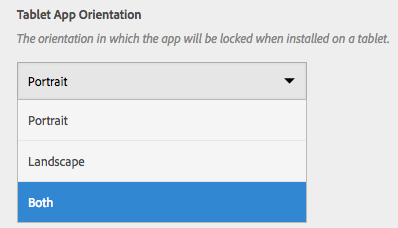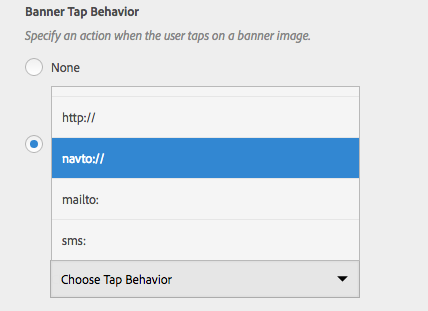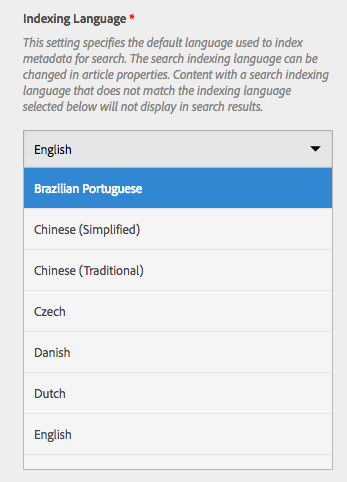Adobe Experience Manager Mobile Version 2016.8, released June 23, includes new and improved features, and several bug fixes.
Features
Device Rotation (iOS)
There is now an option to build an iOS app that allows device rotation. When creating a new iOS app, choose from Portrait, Landscape, or the new option Both for tablet and phone apps orientation in the General tab. When the Both option is chosen, browse pages, any HTML articles, and smooth scrolling PDF articles fill the screen in either orientation. InDesign- or PDF-based fixed layout articles are letterboxed when the device is rotated away from the original orientation.
Note: A custom preflight app is required to test device rotation, as the AEM Preflight app has not yet been updated to allow dual-orientation display.
Most interactive overlays created in InDesign source documents will display properly when the device is rotated. However, these are two known issues to be aware of:
- Inline videos stop and reset on orientation change.
- Image sequence autoplay delay and audio autoplay delay reset on rotation.
More Function Added to Banners
New Cordova-Enabled APIs
Device-level APIs are now available that make it easier to use an article instead of a browse page to display app content. The enhanced getEntity API gathers information for articles, collections, or banners in an app. For any collection entity, there is a new getChildren API, which returns information for articles, collections, or banners within the collection. For example, create an article that uses the APIs to generate a tree view of the entire published entity hierarchy, with hyperlinks to articles or collections to which the user is entitled. Check entitlement status of collections, and use the getThumbnailImage and getBackgroundImage APIs to display fetched information.
Language Support for Search
Choose from multiple languages to use when indexing article metadata for in-app searching, increasing search capabilities in apps. Specify a default search language for articles in project settings and, if necessary, override that setting for any article in article properties.
Search results only list articles whose language setting match the device language setting. For example, articles indexed as English will not appear in search results if the device language is Spanish.
Note: Search is still considered beta at this time.
Distribution of Content in China
A signed “China Addendum” in your Experience Manager Mobile Service Order allows you to provide content to readers in the People’s Republic of China. Once processed, an Enable China Distribution option will appear in the account project settings.
Note: The WeChat social sharing option, popular in China, is now supported.
External Links in HTML Articles
Similar to the setting in the InDesign Overlays panel that offers control over displaying a hyperlink in the in-app browser or external browser, the goto://DeviceBrowser?url= format can now be used in HTML articles to add links that leave the app and open an external browser or app.
Example: <a href=”goto://DeviceBrowser?url=http://www.adobe.com”>Adobe website</a>
Note: The goto: format is not supported in banners.
Android Viewer Improvements
The Persistent Top-Level Content feature is now available in Android viewers. Articles added to the top-level collection can no longer be removed from cache when the cache limit is reached, thus allowing users to view any article in the top-level collection even when they are offline.
Cordova plug-ins enabled in an Android app that require “Accept” prompts are displayed only when browsing articles that use that plug-in.
Example Code Entitlement Service
Users can sign in and become entitled to additional content when entitlement has been set up in your app. Example code has been provided by Adobe for basic entitlement services. Instructions for editing this sample code and uploading it to your server are found at Adobe’s Set up an entitlement service page.
Bug Fixes
This release also includes numerous viewer and service bug fixes. For the complete list, see Adobe’s Bug Fix Release Notes page.
For weekly tips and updates on Adobe Experience Manager Mobile and InDesign, check out our blog and sign up for our newsletters. Want to learn even more and become an InDesign orAEM Mobile expert? Check out all our best-selling handbooks and apps.
Note: Information contained in this post is current at the time of posting. Visit the Technology for Publishing News & Events blog for the latest info on Adobe software releases and functionality.
Posted by: Monica Murphy





